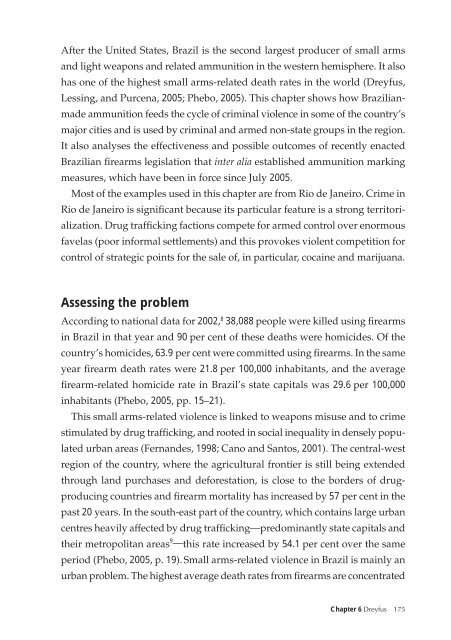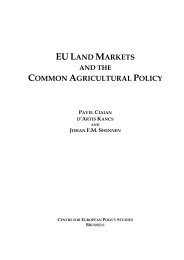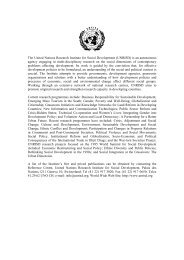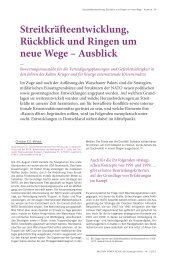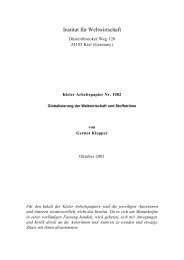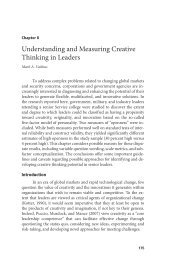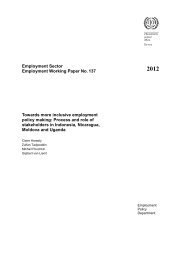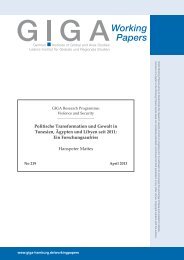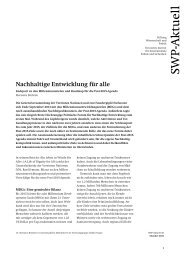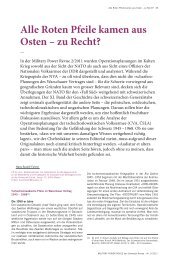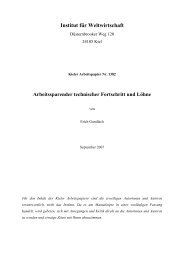Crime and Ammunition Procurement
Crime and Ammunition Procurement
Crime and Ammunition Procurement
Create successful ePaper yourself
Turn your PDF publications into a flip-book with our unique Google optimized e-Paper software.
After the United States, Brazil is the second largest producer of small arms<br />
<strong>and</strong> light weapons <strong>and</strong> related ammunition in the western hemisphere. It also<br />
has one of the highest small arms-related death rates in the world (Dreyfus,<br />
Lessing, <strong>and</strong> Purcena, 2005; Phebo, 2005). This chapter shows how Brazilianmade<br />
ammunition feeds the cycle of criminal violence in some of the country’s<br />
major cities <strong>and</strong> is used by criminal <strong>and</strong> armed non-state groups in the region.<br />
It also analyses the effectiveness <strong>and</strong> possible outcomes of recently enacted<br />
Brazilian fi rearms legislation that inter alia established ammunition marking<br />
measures, which have been in force since July 2005.<br />
Most of the examples used in this chapter are from Rio de Janeiro. <strong>Crime</strong> in<br />
Rio de Janeiro is signifi cant because its particular feature is a strong territorialization.<br />
Drug traffi cking factions compete for armed control over enormous<br />
favelas (poor informal settlements) <strong>and</strong> this provokes violent competition for<br />
control of strategic points for the sale of, in particular, cocaine <strong>and</strong> marijuana.<br />
Assessing the problem<br />
According to national data for 2002, 8 38,088 people were killed using fi rearms<br />
in Brazil in that year <strong>and</strong> 90 per cent of these deaths were homicides. Of the<br />
country’s homicides, 63.9 per cent were committed using fi rearms. In the same<br />
year fi rearm death rates were 21.8 per 100,000 inhabitants, <strong>and</strong> the average<br />
fi rearm-related homicide rate in Brazil’s state capitals was 29.6 per 100,000<br />
inhabitants (Phebo, 2005, pp. 15–21).<br />
This small arms-related violence is linked to weapons misuse <strong>and</strong> to crime<br />
stimulated by drug traffi cking, <strong>and</strong> rooted in social inequality in densely populated<br />
urban areas (Fern<strong>and</strong>es, 1998; Cano <strong>and</strong> Santos, 2001). The central-west<br />
region of the country, where the agricultural frontier is still being extended<br />
through l<strong>and</strong> purchases <strong>and</strong> deforestation, is close to the borders of drugproducing<br />
countries <strong>and</strong> fi rearm mortality has increased by 57 per cent in the<br />
past 20 years. In the south-east part of the country, which contains large urban<br />
centres heavily affected by drug traffi cking—predominantly state capitals <strong>and</strong><br />
their metropolitan areas 9 —this rate increased by 54.1 per cent over the same<br />
period (Phebo, 2005, p. 19). Small arms-related violence in Brazil is mainly an<br />
urban problem. The highest average death rates from fi rearms are concentrated<br />
Chapter 6 Dreyfus 175


